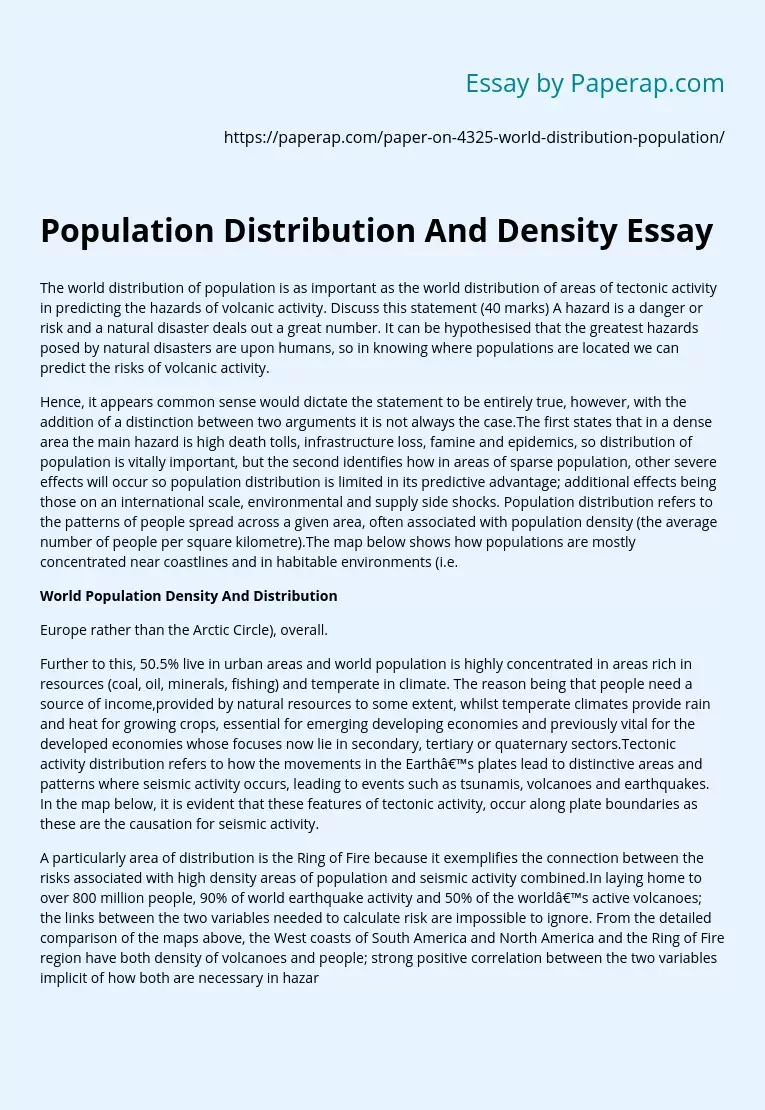Population Distribution And Density Essay
The following sample essay is about population distribution and density. To read the introduction, body, and conclusion of the essay, scroll down.
The world distribution of population is as important as the world distribution of areas of tectonic activity in predicting the hazards of volcanic activity.
Discuss this statement (40 marks) A hazard is a danger or risk and a natural disaster deals out a great number. It can be hypothesised that the greatest hazards posed by natural disasters are upon humans, so in knowing where populations are located we can predict the risks of volcanic activity.
Hence, it appears common sense would dictate the statement to be entirely true, however, with the addition of a distinction between two arguments it is not always the case.The first states that in a dense area the main hazard is high death tolls, infrastructure loss, famine and epidemics, so distribution of population is vitally important, but the second identifies how in areas of sparse population, other severe effects will occur so population distribution is limited in its predictive advantage; additional effects being those on an international scale, environmental and supply side shocks.
Population distribution refers to the patterns of people spread across a given area, often associated with population density (the average number of people per square kilometre).The map below shows how populations are mostly concentrated near coastlines and in habitable environments (i.e.
Further to this, 50.5% live in urban areas and world population is highly concentrated in areas rich in resources (coal, oil, minerals, fishing) and temperate in climate.
The reason being that people need a source of income,provided by natural resources to some extent, whilst temperate climates provide rain and heat for growing crops, essential for emerging developing economies and previously vital for the developed economies whose focuses now lie in secondary, tertiary or quaternary sectors.Tectonic activity distribution refers to how the movements in the Earth’s plates lead to distinctive areas and patterns where seismic activity occurs, leading to events such as tsunamis, volcanoes and earthquakes. In the map below, it is evident that these features of tectonic activity, occur along plate boundaries as these are the causation for seismic activity.
A particularly area of distribution is the Ring of Fire because it exemplifies the connection between the risks associated with high density areas of population and seismic activity combined.In laying home to over 800 million people, 90% of world earthquake activity and 50% of the world’s active volcanoes; the links between the two variables needed to calculate risk are impossible to ignore. From the detailed comparison of the maps above, the West coasts of South America and North America and the Ring of Fire region have both density of volcanoes and people; strong positive correlation between the two variables implicit of how both are necessary in hazard prediction. However, the volcanoes will always stay in situe so the dynamic changes of population density do appear more dominant in terms of volcanic hazards.In using the population trends stated previously there are a great many factors drawing people into areas of seismic activity so population distribution is only going to increase in density within seismic prone areas, so human dispersion is vital in recognising both future and current hazards. All preceding knowledge is summed up in Kofi Annan’s assessment:”At no time in human history have so many people lived in cities clustered around seismically active areas…Poor land-use planning; environmental mismanagement; and a lack of regulatory mechanisms both increase the risk and exacerbate the effects of disasters,” which clearly illustrates the relationship between volcanic disasters, populations, planning and development; demonstrating the vital influence of population change in risk reduction.
Furthermore, humans being the victims of the greatest hazard is emphatic given half a billion people live in ‘spitting distance’ of active volcanoes. Therefore, all such theory leads me to exemplify the two arguments stated previously: In light of the first argument, the main hazard to any natural disaster is humans, so in densely populated areas their location must be taken into account. In the case of the Mount Nyiragongo eruption (Congo), its proximity to the dense population of the city of Goma, 16km south-west of the volcano, increased hazards. With a population of 500,000 people, 147 were killed because the 40mph lava flows reached the densely populated area quickly.1/3 of Goma was destroyed along with 14 villages along the path to Goma, from the Volcano and through the valley. Therefore, such an eruption would have benefited from focus on the population dispersion analysis rather than just when the volcano would erupt because evacuations needed to have been put in place. The pseudo-mathematical equation for risk ‘Risk = Hazard x Value x Vulnerability / Capacity’ (Value indicating the elements at risk (number of human lives, economic value of property, etc., while vulnerability refers to factors which increase the susceptibility to he impact of hazards) highlights how the number of human lives and property at risk and the susceptibility of these individuals is a bigger factor than the simplicity of seismic activity distribution because the environment can recoup and the volcano is the effector not the effected. More importantly, the density of ‘Value’ and ‘Vulnerability’
Population Distribution And Density Essay. (2019, Dec 05). Retrieved from https://paperap.com/paper-on-4325-world-distribution-population/

